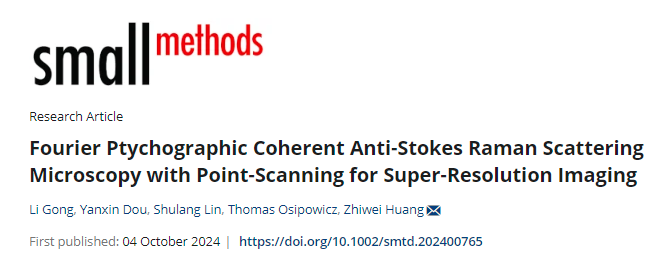New Breakthroughs in the Field of Label-free Super-resolution Imaging
A research team led by Associate Professor Huang Zhiwei, the Senior Principal Investigator from the Biomedical and Health Technology Research Platform of NUSRI Suzhou, has published their results in the journal Small Methods. The team has developed a novel point-scanning Fourier ptychographic coherent anti-Stokes Raman scattering microscopy (PS-FP-CARS) technique, bringing in a breakthrough to label-free super-resolution molecular imaging. PS-FP-CARS not only significantly improves the imaging resolution, but also broadens the development of precision chemical imaging technology in the biological and biomedical systems.

Fourier ptychography (FP) is a high resolution wide-field imaging method based on the extended aperture in the Fourier space, which is synthesised from raw images with varying illumination angles. If FP is extended to coherent nonlinear optical imaging, the resolution could be further improved due to the increase of the cutoff frequency of the synthesised coherent optical transfer function (C-OTF) with respect to the order of nonlinear optical processes. However, there is a fundamental conflict between wide-field FP and nonlinear optical imaging, whereby the nonlinear optical imaging typically requires a focused excitation laser beam with high power density.
To tackle the problem, in this work, a unique point-scanning Fourier ptychography (PS-FP) method is presented for super-resolution nonlinear optical imaging, in which the nonlinear optical signal is obtained by using focused laser beam, while the conventional FP algorithm can still be used to retrieve the super-resolution image. PS-FP coherent anti-Stokes Raman scattering (PS-FP-CARS) imaging on a variety of samples, where a 1.8-fold expansion of the OTF is achieved experimentally for enhancing vibrational imaging. Further theoretical calculation shows that the C-OTF of PS-FP higher-order CARS (PS-FP-HO-CARS) can be expanded up to ≈4.9-fold, thereby improving the spatial resolution by ≈3-fold in comparison with conventional point-scanning CARS under tightly focused beams.
The PS-FP-CARS technology has significant advantages in label-free super-resolution imaging in bioimaging. It can provide high-precision molecular imaging at the cellular and tissue levels which is especially suitable for identifying cell structure, lipid and protein distributions, and other key molecular features in biological and biomedical systems. PS-DP-CARS also provides new means for cancer detection, drug development and cellular molecular imaging, allowing the chemical structure and compositions in biosamples to be observed in a non-destructive manner. In addition, due to the generality of the PS-FP method, it can be readily extended to other coherent nonlinear optical imaging modalities (e.g., second-and third-harmonic generation microscopy) for tissue and cell super-resolution imaging, opening up new fields in early diagnosis of diseases, drug delivery and targeting research and other aspects in the biological and biomedical fields.




